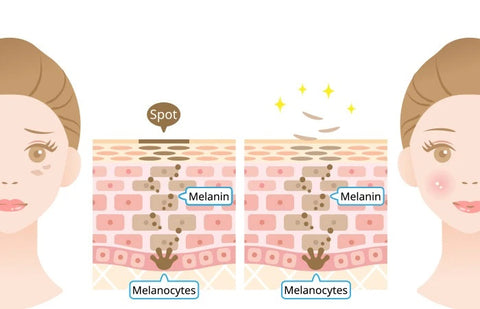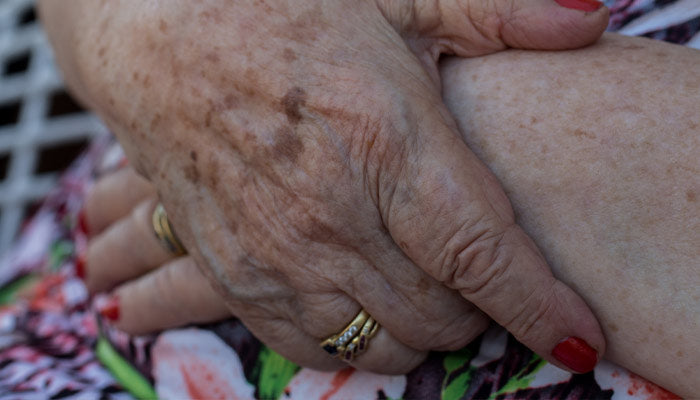If your pretty face is being engulfed by dark spots, you are not alone! Dark spots usually occur as a result of hyperpigmentation.
Sometimes, the body tends to overproduce melanin (the pigment that gives your skin, eyes and hair their color) in some areas. The more the melanin, the darker the shade.
Fortunately, dark spots tend to fade away with time if you make the right analysis of your skin and take the necessary steps. Home remedies, over-the-counter products and dermatological solutions can help reduce dark spots faster.
Highlights:
1. What Causes Dark Spots?
A. Sun Exposure
The most common cause is direct exposure to the sun’s UV rays.
B. Melasma
Dark spots can also be the result of certain skin conditions like melasma. This is more common in women and causes discoloration in small patches of the body. It is usually observed during pregnancy.

C. Medication
Certain medications like non-steroidal anti-inflammatory drugs and psychotropic drugs can lead to hyper-pigmentation.
D. Inflammation/Wounds
Sometimes, a dark spot may be left behind after a pimple/acne outbreak. This usually fades away with time. People with lighter skin tones tend to have red/purple spots. Those with a darker complexion typically have brown spots.
A wound may also leave behind a dark spot that fades away with time.
E. Skin Products
One must always be careful about what they use on their skin. Some products may cause irritation and leave a dark patch behind.
2. Symptoms of Dark Spots
Your skin-tone usually determines the color of a dark spot. They range from light brown to dark brown. They have the same texture as your skin and are not painful.
Dark spots usually occur in places of your body that are exposed to the sun on a regular basis. This includes your face, arms, neck and back.

3. How Can You Treat Dark Spots on Your Face?
A. Hydroquinone
Hydroquinone is a common ingredient in skin-lightening medicated creams, cleansers and moisturizers. It has been used as a skin-lightening agent for years.
How Does it Work?
Hydroquinone regulates melanin production in the affected area. (1) It reduces the number of melanocytes and can take a few weeks or months to see results.
For stronger concentrations of the product, a prescription is mandatory.
Note:
- The most common side-effect of using Hydroquinone is ‘ghosting’ - the product bleaches the area around the dark spot along with it.
- If you have sensitive skin, you may experience redness and dryness. (2)
- Hydroquinone, in rare cases, leads to a condition called Ochronosis. The result of this condition is pigmentation and pustules. It can happen after more than five months of using the product.
Hydroquinone may not be the best product for everybody. It is recommended for you to use it only after consulting a dermatologist.
Apply a small amount of the product on the back of your hand. Cover the area with a bandage (to avoid contact with other parts of your body). Wait for about 24 hours. If your skin doesn’t get dry, irritated or red, go ahead and use the product.
B. Retinoids
Retinoids came into the market as a treatment for acne. Today, they are used to reduce the appearance of wrinkles, scars and dark spots(3). However, it will benefit if you take a skin quiz before you proceed with any treatment.
Benefits of Retinoids
Retinoids prompt old skin cells to turn over. They make way for new skin cells to form. This helps reduce the appearance of dark spots.
They hamper the breakdown of collagen in the body and thicken the skin.
Note:Retinoids can cause dryness and redness. This usually happens during the first few weeks of application/consumption.
C. Alpha Hydroxy Acids
Alpha Hydroxy Acids (AHA’s) are organic acids. They are derived from plants and animals and are available across nature. A popular ingredient in skincare products, AHAs come in the form of creams, serums and lotions.
Commonly used AHAs
- Glycolic acid - derived from sugarcane
- Lactic acid - derived from sour milk
- Citric and malic acid - derived from fruits
- Hydroxycaprylic acid - derived from animals
Studies suggest that the efficacy of AHAs depends on concentration levels and exposure time. (4)
For example, rinse-off shampoos and conditioners provide almost no benefit of AHAs. This is because these products are washed off in a matter of minutes. They do not allow the body to absorb the acid thoroughly.
Benefits of AHAs
AHAs are used by dermatologists in chemical peels. They help treat acne scars, wrinkles, sunspots, age-spots and reduce discoloration.
Reports show that AHAs can also prevent ultraviolet skin tumor development. (5)
AHAs are used to treat a wide range of skin issues. Glycolic acid and lactic acid are considered to be the most effective of the lot. (6)
How Do AHAs Help Treat Dark Spots?
AHAs contain antioxidant and anti-inflammatory properties. This increases blood flow that speeds up the skin’s healing process.
It helps the skin to create new cells that are evenly pigmented. This lightens dark spots and reduces discoloration. (7)
D. Glycolic Acid
Glycolic acid is an alpha-hydroxy acid that stimulates collagen growth in the skin.
How it Helps Prevent Dark Spots
It exfoliates the skin. This removes dead skin cells and lightens dark spots. Many over the counter products use 3-10 % of this ingredient.
Note:Glycolic acid is not recommended if you’re on topical medication. It is advised to consult a professional before using it.
E. Kojic Acid
Kojic Acid is used in many skin lightening products. It comes in the form of creams, gels and lotions. This lightening agent is sold at 1% or lower concentration levels in cosmetic products. (8) It is used to treat dark spots, hyperpigmentation and melasma.
How Does it Work?
An amino acid called tyrosine handles melanin production in the skin. Kojic acid blocks tyrosine formation, which reduces the production of melanin.
Kojic acid can be used to reduce the appearance of age spots, sunspots, melasma, dark spots and discoloration.
Note:Using Kojic acid in high concentrations or in its raw form is not recommended.
- Sunburn
Melanin prevents the skin from sun damage. Kojic acid blocks melanin production in the body. This can make a person vulnerable to sunburns.
- Itching and redness
High concentrations of Kojic acid may lead to irritation, itching and redness of the skin. People with sensitive skin should conduct a patch test before using it.
F. Salicylic Acid
Salicylic acid is a peeling agent. It causes the outer layer of the skin to shed off.
Studies show that products containing salicylic acid provide depigmentation benefits. They are also pleasant to use. (9)
Note:Salicylic acid may cause allergic reactions and skin irritation. A patch test is recommended for those with sensitive skin.
G. Chemical Peels
Chemical peels work as exfoliators. They peel off the top layer of your skin. This reduces spots, discoloration and the appearance of scars.
How They Help
Chemical peels can be used in combination with other skin-lightening agents. They help in reducing the appearance of dark spots.
Note:Chemical peels are suitable for any skin type. However, a chemical peel that is too powerful may cause redness and irritation to the skin. It is advised to consult a professional before using a peel.
H. Laser Treatments
Your dermatologist may recommend laser therapy to increase the pace of improvement. It aims at speeding up the process by removing the top layer of your skin to reduce dark spots and discoloration.
However, laser therapy does not target melanin production in your body. There may also be a possibility of recurrence after treatment. Laser therapy is expensive as compared to other ways of treating dark spots.
Note:Laser therapy does not work for all skin types. After studying your skin, your dermatologist may or may not recommend laser treatment for you. (10)
I. Microdermabrasion
Microdermabrasion is a non-surgical in-office procedure.This method is used to renew skin tone and overall texture.
Microdermabrasion smoothens the skin. It helps to reduce fine lines, wrinkles, age spots, dark spots, sunspots and acne scars. The best part is it suits all skin types. You can see instant results after this one-hour long procedure.
Note: Microdermabrasion doesn’t have harsh side-effects. Mild tenderness, swelling and redness may occur after the procedure. This subsides after a few hours. Microdermabrasion may also result in mild bruising. It is advised to use a moisturizer to avoid dry skin.
4. Home Remedies to Treat Dark Spots
These at-home treatments are used to reduce dark spots by men and women all over the world.Choose the right ingredients based on your skin type.
A. Aloe Vera
Aloin is an active compound of the aloe vera plant. Studies show that aloin and the leaf extract of the plant have skin-lightening properties. It is commonly used by people to lighten dark spots. (11)
B. Vitamin C
Citrus fruits like oranges, mandarins and lemons are rich in Vitamin C. They are effective in lightening sunspots and increase collagen production in the body. (12)
Lemon juice is widely used as a home remedy to treat a variety of skin issues. It is a popular ingredient in many skin-lightening products. However, its acidic qualities may irritate the skin and cause dryness. Lemon juice is not recommended for people with sensitive skin.
C. Yogurt
Yogurt contains lactic acid that helps reduce the appearance of dark spots. The combination of lemon and yogurt makes for a great face mask!
D. Calamine Lotion
Calamine lotion is used to treat mild skin ailments. These include sunburns, itchiness and redness. Calamine lotion is listed on the World Health Organization’s “List of Essential Medicines”.
Calamine lotion contains Kaolin, which is used in dark spot removal creams. Consistent application of the lotion can lighten dark spots.
E. Orange Peel
Orange peel contains hesperidin. Research shows that this ingredient helps lighten dark spots. (13)
An orange peel face mask can be made by mixing dry orange peel powder with water. Apply it to the affected area, not more than once a day.
5. How to Prevent Dark Spots?
The main cause of dark spots is direct exposure to the sun. Ultraviolet rays increase the production of melanin in the skin. Keep the following preventive measures in mind:
A. Sunscreen
Sunscreen plays a vital role in protecting your skin from ultraviolet rays. Choose a sunscreen that suits your skin type. It should be worn on a daily basis to avoid hyperpigmentation.
B. Cover With Hat or Cloth
If you’re adventurous and love staying out in the sun for long hours, carry a hat or a stole. Protect your face from direct sun exposure with these accessories.
In today’s technologically-advanced world, hyperpigmentation and dark spots can be treated easily. Consult a professional before undergoing treatment for effective results.
Customized skincare solves your problem of experimenting with random skincare products.
Skinkraft customized skin care recommends a 3-step regimen based on a SkinID™ questionnaire.
You will get a
- Customized cleanser
- Customized moisturizer
- An active to treat your concern
1. https://www.ncbi.nlm.nih.gov/books/NBK539693/
2. https://www.ncbi.nlm.nih.gov/pubmed/28095558
3. https://www.ncbi.nlm.nih.gov/pmc/articles/PMC2807702/
4. https://www.ncbi.nlm.nih.gov/pmc/articles/PMC6017965/
5. https://www.ncbi.nlm.nih.gov/pubmed/21921960
6. https://www.fda.gov/cosmetics/cosmetic-ingredients/alpha-hydroxy-acids
7. https://www.ncbi.nlm.nih.gov/pmc/articles/PMC3875240/
8. https://ec.europa.eu/health/ph_risk/committees/04_sccp/docs/sccp_o_148.pdf
9. https://www.ncbi.nlm.nih.gov/pubmed/23377328
10. https://www.ncbi.nlm.nih.gov/pmc/articles/PMC5418955/
11. https://onlinelibrary.wiley.com/doi/abs/10.1111/j.1468-2494.2008.00432.x
Recommended Products
Was this Article helpful?
- Least helpful
- Most helpful





